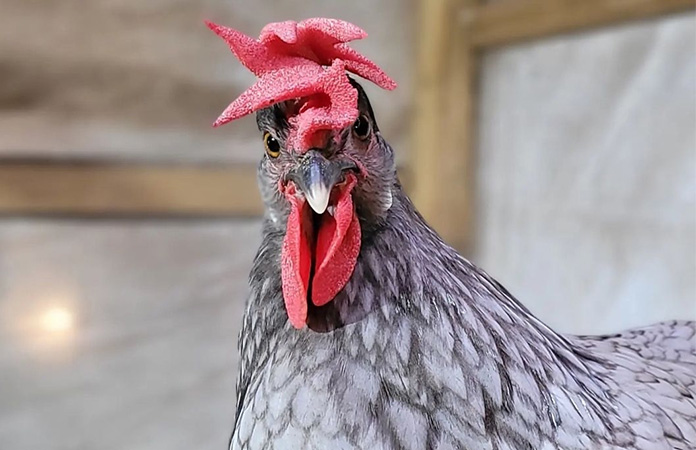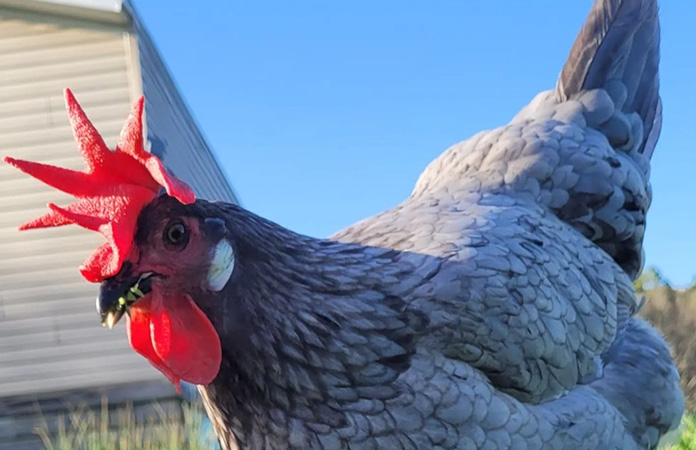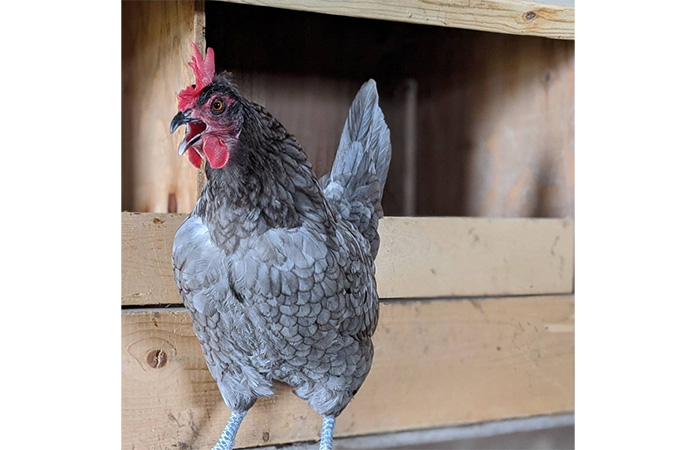Andalusian Chicken: Interesting Facts About This Blue Breed

The Andalusian chicken claims the top spot for a breed with a strikingly elegant appearance based on its feathers and a perfectly formed Mohawk. The Blue Andalusian chicken, with its exquisite blue-grey plumage, is truly a sight to behold. These magnificent birds are a great addition to any flock.
- Andalusian hens lay up to 200 eggs yearly
- Meditteranean breed so stands heat well
- Active chickens, love to free-range
- Seldom broody
| Eggs | Up to 200 eggs/year |
| Egg Color | White |
| Egg Size | Large |
| Weight | 5.7 – 7 lbs |
| Hardiness | Cold & heat |
| Temperament | Active & vocal |
| Beginner-friendly | Medium |
| Color | Blue is the only recognized color, but white and black are also possible |
Characteristics
The Blue Andalusian’s slate-blue feathers are their most distinctive feature. Normal lacing is blue or black, although some hens may have no lacing. A Blue Laced Andalusian chicken has four toes on each foot and no feathers on its legs.
The quality of the Andalusian chicken’s pedigree affects the color and lacing’s intensity. Birds of higher quality will have darker black or blue lacing and a lighter grey-blue shade.
The blue in the original specimens was much paler than it is now. And although blue is the only APA-recognized color, when crossing two blue-colored chickens, 25% will be black, and 25% will be (off) white.
This bird has a single comb, vivid scarlet wattles, and white and ovular earlobes. The comb is often floppy. Andalusian hens have reddish-brown eyes and beaks colored like horns and slightly curved downward.

Egg Production
The output of Andalusian chickens is remarkable; they produce 160–200 medium to large white eggs annually and are great winter egg producers.
Andalusian hens rarely become broody and are not particularly interested in sitting on eggs. The eggs of this breed are best placed in an incubator if you want chicks.
A Blue Andalusian pullet (a hen under a year old) can lay eggs much earlier than many other chicken breeds. Pullets start laying when they are about 5 to 6 months old.
Personality
Andalusians adore freedom and would much rather be allowed to forage for food and exercise independently. This type of chicken is peaceful and curious, yet it is not the most docile. They are not hostile by any means but do not expect them to remain still for long to be handled or petted.
In general, blue Andalusian chickens get along well with other chicken breeds. They are calm, laid-back birds and typically do not have bullying difficulties. Roosters tend to be very noisy, which is something to remember when living in a suburban area.
This breed requires a lot of space because they dislike crowds and love to free range. They may harass or fight other chickens if kept in cramped conditions and even rip off their feathers.

Although they are not particularly friendly, blue Andalusian chickens are neither hostile. Despite being curious and brave, they dislike being picked up.
Because they are independent and like to roam, blue Andalusians will not stay still for very long.
Andalusian chickens are a Mediterranean breed, which means they can stand warm temperatures better than other chickens. They are also cold-hardy but are best to be kept in a warmer climate.
Breed History
Although the true origin of an Andalusian chicken is still a mystery, it is widely believed that this race originated when Black Castilians were crossed with other chickens in localized areas of Castile, Spain. The Andalusian people’s motherland and origin are centered in the Utrera region, where they are more numerous.
Despite what their name might imply, they might not be Andalusians. To learn more about Blue Andalusians, Harrison Weir traveled to Andalusia in 1879, although this region was largely unaware of it. Because of this, the Blue Andalusian is believed to have nothing to do with the Spanish region Andalusia.
Leonard Barber brought the Andalusian chicken to England in the 1840s. It debuted in England in 1853 at the Baker Street, London show.
Summary
A high-quality example of this fowl is quite breathtaking to see. The feathers have a beautiful blue that is interwoven with black. It goes without saying that raising a bird to this perfection takes time and effort, but the effort is always worthwhile.
If you wish to keep these lovely animals and reside in a colder region of the country, you might need to add a little heat at night to maintain a comfortable temperature. Besides that, this breed requires little maintenance and prefers to keep humans at a distance.
To learn more about chicken breeds, check out our ‘Chicken Breeds Page‘ to see every specific breed we address. Or go to our listicle breed summary on ‘The Classroom‘, or, if you’re unsure where to start, take a look at our ‘Chicken Breeds: Ultimate Beginners Guide‘.
If you’re interested in more blue-colored breeds, take a look at our breed profiles on the Sapphire Splash, Sapphire Gem, or Sapphire Olive Egger.
Credits Featured Image: @brandy_l_m_ (IG)






















